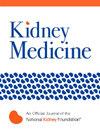Association of Plasma KIM-1, TNFR-1, and TNFR-2 With Cardiovascular Outcomes and All-Cause Mortality in Individuals With Chronic Kidney Disease: An Ancillary Analysis of SPRINT
IF 3.4
Q1 UROLOGY & NEPHROLOGY
引用次数: 0
Abstract
Rationale & Objective
Among individuals with chronic kidney disease (CKD), higher blood levels of kidney injury molecule-1 (KIM-1) and soluble tumor necrosis factor receptors (TNFR-1 and TNFR-2) have been associated with greater risk of CKD progression. Their associations with risk of cardiovascular disease (CVD) and all-cause mortality in individuals with CKD remain uncertain.
Study Design
An observational cohort study.
Setting & Participants
Systolic Blood Pressure Intervention Trial participants with hypertension and CKD (eGFR <60 mL/min/1.73 m2) but without diabetes.
Predictors
Plasma KIM-1, TNFR-1, and TNFR-2.
Outcomes
A composite CVD outcome (acute coronary syndrome/myocardial infarction, stroke, heart failure, and CVD death) and all-cause mortality.
Analytic Approach
Cox proportional hazards models, adjusting for CVD risk factors, eGFR, and urine albumin-to-creatinine ratio.
Results
Total of 2,350 participants with a mean age of 73 ± 9 years, eGFR of 46 ± 10 mL/min/1.73m2 and 25% prevalence of CVD. Over more than 3 years follow-up, 293 CVD events (12%) and 160 deaths (7%) occurred. Higher KIM-1, TNFR-1, and TNFR-2 were associated with higher risk of the composite CVD outcome after adjusting for CVD risk factors, but associations were no longer significant after adjusting for eGFR and urine albumin-to-creatinine ratio (KIM-1: HR = 1.13, 95% CI, 0.99-1.30; TNFR-1: HR = 1.03, 95% CI, 0.72-1.46; TNFR-2: HR = 0.98, 95% CI, 0.76-1.26). In contrast, in fully adjusted models, higher plasma KIM-1 and TNFR-1, but not TNFR-2, were associated with higher risk of all-cause mortality (KIM-1: HR = 1.23, 95% CI, 1.01-1.49; TNFR-1: HR = 2.09, 95% CI, 1.14-3.83; TNFR-2: HR = 1.19, 95% CI, 0.85-1.66).
Limitations
No individuals with diabetes or stroke.
Conclusions
In individuals with hypertension and nondiabetic CKD, associations of higher plasma KIM-1, TNFR-1, and TNFR-2 concentrations with CVD events were not independent of eGFR and albuminuria, whereas higher levels of plasma KIM-1 and TNFR-1 were independently associated with greater risk of all-cause mortality.
Plain-Language Summary
Blood levels of kidney injury molecule-1 (KIM-1) and soluble tumor necrosis factor receptors (TNFR-1 and TNFR-2) have been associated with progression of kidney disease. We evaluated if these biomarkers were associated with risk of cardiovascular events and all-cause mortality in individuals without diabetes with hypertension and chronic kidney disease from the Systolic Blood Pressure Intervention Trial adjusting for relevant risk factors and biomarkers. We found none of the biomarkers were associated with risk of cardiovascular events, whereas KIM-1 and TNFR-1 were associated with risk of all-cause mortality. These findings suggest KIM-1 and TNFR-1 may be useful for risk prediction and emphasize the importance of inflammation as a risk factor for mortality.
血浆KIM-1、TNFR-1和TNFR-2与慢性肾病患者心血管结局和全因死亡率的关系:SPRINT的辅助分析
基本原理及在慢性肾脏疾病(CKD)患者中,较高的血液肾损伤分子-1 (KIM-1)和可溶性肿瘤坏死因子受体(TNFR-1和TNFR-2)水平与CKD进展的高风险相关。它们与CKD患者心血管疾病(CVD)风险和全因死亡率的关系仍不确定。研究设计:观察性队列研究。设置,参与者收缩压干预试验参与者有高血压和CKD (eGFR <60 mL/min/1.73 m2),但没有糖尿病。预测血浆KIM-1、TNFR-1和TNFR-2。综合CVD结果(急性冠状动脉综合征/心肌梗死、中风、心力衰竭和CVD死亡)和全因死亡率。分析方法:cox比例风险模型,调整心血管疾病危险因素、eGFR和尿白蛋白与肌酐比值。结果2350名参与者平均年龄73±9岁,eGFR为46±10 mL/min/1.73m2,心血管疾病患病率为25%。在3年多的随访中,发生293例CVD事件(12%)和160例死亡(7%)。在调整心血管疾病危险因素后,较高的KIM-1、TNFR-1和TNFR-2与心血管疾病综合结局的高风险相关,但在调整eGFR和尿白蛋白与肌酐比后,相关性不再显著(KIM-1: HR = 1.13, 95% CI, 0.99-1.30;Tnfr-1: hr = 1.03, 95% ci, 0.72-1.46;Tnfr-2: hr = 0.98, 95% ci, 0.76-1.26)。相反,在完全调整后的模型中,血浆中较高的KIM-1和TNFR-1与全因死亡风险较高相关,但TNFR-2不相关(KIM-1: HR = 1.23, 95% CI, 1.01-1.49;Tnfr-1: hr = 2.09, 95% ci, 1.14-3.83;Tnfr-2: hr = 1.19, 95% ci, 0.85-1.66)。限制:没有糖尿病或中风患者。结论在高血压和非糖尿病性CKD患者中,血浆中较高的KIM-1、TNFR-1和TNFR-2浓度与CVD事件的关联并非独立于eGFR和蛋白尿,而血浆中较高的KIM-1和TNFR-1水平与更高的全因死亡风险独立相关。肾损伤分子-1 (KIM-1)和可溶性肿瘤坏死因子受体(TNFR-1和TNFR-2)的血液水平与肾脏疾病的进展有关。在收缩压干预试验中,我们评估了这些生物标志物是否与无糖尿病合并高血压和慢性肾脏疾病患者的心血管事件风险和全因死亡率相关,并对相关危险因素和生物标志物进行了调整。我们发现没有任何生物标志物与心血管事件风险相关,而KIM-1和TNFR-1与全因死亡率风险相关。这些发现表明,KIM-1和TNFR-1可能对风险预测有用,并强调炎症作为死亡风险因素的重要性。
本文章由计算机程序翻译,如有差异,请以英文原文为准。
求助全文
约1分钟内获得全文
求助全文

 求助内容:
求助内容: 应助结果提醒方式:
应助结果提醒方式:


